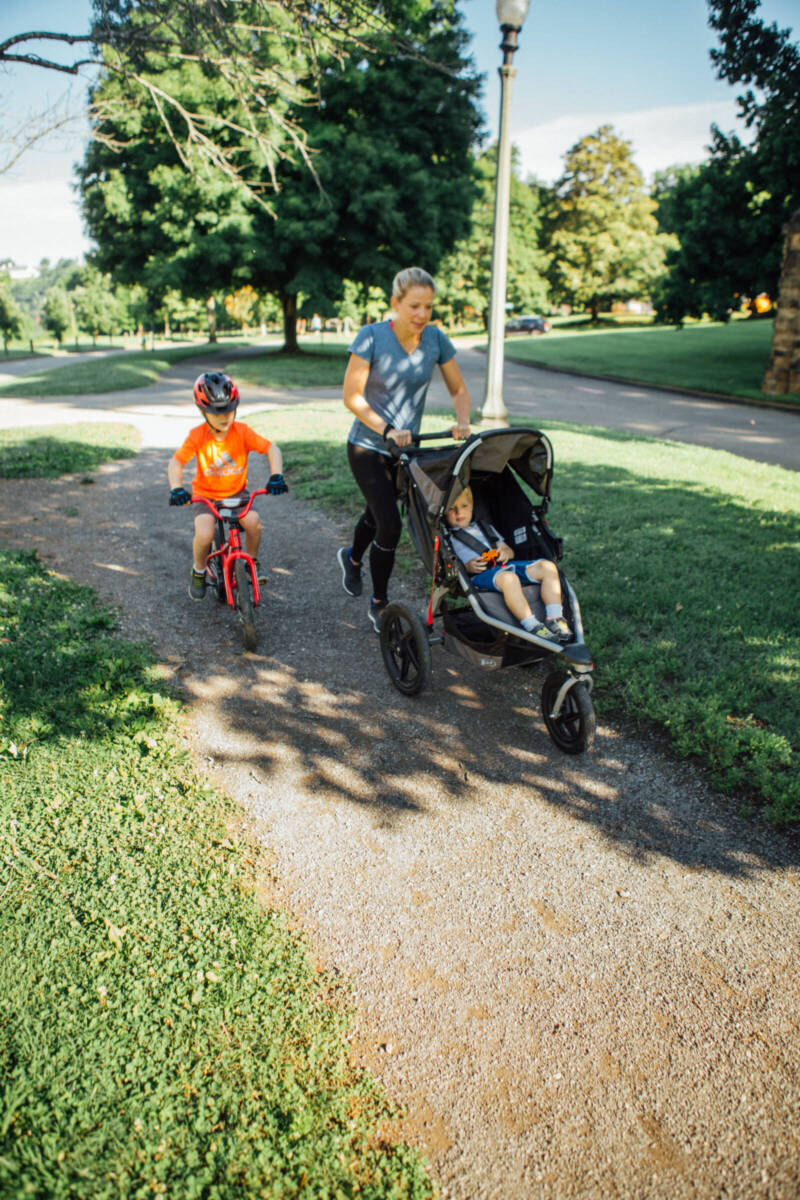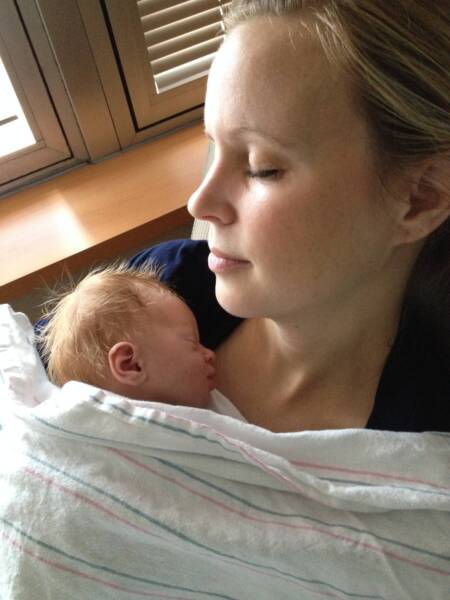Energy Gels, Running, and Breastfeeding: Safe or Risky?
Energy gels and breastfeeding can work together if you choose the right energy gel and time caffeinated gels at least one hour before breastfeeding your baby. Choose energy gels that are third-party certified and have extra electrolytes to ensure safety and hydration.

Energy gels and breastfeeding may seem like an odd pair—but the two can go together very well. Why? Because fueling your running not only helps with performance but can also help with maintaining your breast milk as your body requires more calories for lactation. Your body also needs more electrolytes which most energy gels contain.
Table of contents
Though a breastfeeding runner may be concerned that the sugar or caffeine in an energy gel will be passed along to their baby. The good news is most energy gels do not contain these ingredients unless specified. Indeed, I never had any issues taking energy gels and having it affect my baby when I was nursing.
If trying to figure out how to make your run fueling plan and breastfeeding plan work is too complicated, don’t worry! I am going to break down all you need to know about energy gels and breastfeeding. (And don’t miss my article on the safety of pre-workouts for breastfeeding runners). So, let’s go!
The Science of Energy Gels and Breastfeeding
I got with Melanie Sulaver, a registered dietitian who specializes in working with postpartum women. Sulaver notes there is no research on breastfeeding athletes and the consumption of energy gels (which are usually little packets of easily converted fuel such as carbohydrates). However, there is enough knowledge to know what energy gels are safe for breastfeeding, and what are not.
Sulaver suggests, being conscious of energy gels that contain caffeine. Knowing that caffeine recommendations for breastfeeding mothers are a max of 300mg /day total. Some caffeinated energy gels can contain half that amount.
This doesn’t mean you can’t utilize caffeinated gels to maximize performance, notes Sulaver, but you need to factor that into their total daily caffeine intake. And, avoid taking a caffeinated gel with an hour of breastfeeding.
Taking in carbs and glucose commonly found in energy gels does not pose a safety risk for breastfeeding runners. That said, there are some safety considerations for breastfeeding and energy gels.
7 Safety Considerations
1. Check with your healthcare provider.
Before embarking on a journey such as long-distance running postpartum, check with your healthcare provider. Make sure they are on board with your goals including how you fuel your runs.
2. Space out caffeinated energy gels.
As noted, the use of caffeine should be avoided when close to breastfeeding your baby. Caffeine can be transferred into breast milk in small amounts, notes Sulaver. “Typically, caffeine levels in breast milk peak about 1-2 hours after consumption. After this, the levels gradually decrease,” she says, suggesting breastfeeding runners wait 1-2 hours after having a caffeinated gel before nursing to ensure the caffeine has been metabolized.
3. Monitor your baby.
Pay attention to how your baby behaves after you have breastfed them after fueling with energy gels. Look for signs of distress, anxiety, or irritability. It may be helpful to keep a journal that logs the time you take your energy gels before breastfeeding, and how your baby responds.
4. Choose third-party tested energy gels.
Sulaver recommends choosing third-party tested energy gels. The supplement world is loosely regulated so choosing an energy gel that has been certified by a third party can ensure what you are consuming matches the packaging. Sulaver says checking the Informed-Sport or NSF websites would be a good starting point.
“It is worth noting there are smaller third-party labs that companies might use to do their testing. Check the companies FAQ section of their website and if there is no reference to third-party testing you can reach out to them directly or opt for a different product,” she suggests.5. Fuel more.
It’s important to remember that our energetic demands are HIGHER postpartum than they were during pregnancy. “The estimation is at least 500 additional calories for breastfeeding alone,” Sulaver notes. “That’s just for breastfeeding, exclusive of the energetic demands for return to running.”
So, utilizing gels as an additional carbohydrate source can be super helpful. Aim to consume at least 60 g of carbs per hour of running. Get complete guidance on how to fuel your long runs here and meal ideas for after your long runs.6. Optimize hydration.
Hydration is especially important during lactation. A runner who is breastfeeding needs more fluid to maintain health and milk supply. Sulaver suggests choosing energy gels that contain higher sodium, potassium, and magnesium (electrolytes) content.
Breastfeeding runners want to take in at least 400mg of sodium per hour of running and pre-hydrate with at least that amount before running. Sulaver recommends taking in 100-128 ounces of water (preferably with electrolytes) per day.
7. Hire a running coach.
It is always my recommendation to hire a running coach if you can (even if it is not me!) to help guide on your marathon feeding plan – and goals, in general! I cannot tell you how many times I have helped athletes side-step health issues to stay healthy and on track.
A running coach with experience with postpartum runners has the knowledge from research and coaching to help you chase your goals in the healthiest way for you and your baby.
How to Choose the Right Energy Gel
Tip 1: What’s your flavor (and texture)?
Think about whether you like chocolate, vanilla, honey, or fruit-flavored foods and drink. Do you like thick or thin textures? What is easy for you to take in while running? And what is easy to open? Think about whether you want caffeine and if you will get your sodium in the energy gel, salt tabs, or sports drink.
Tip 2: Get a selection.
Once you have an idea of what you are looking for, go to your local running store and buy a selection of energy gels. Then start trying them on your next run!
Tip 3: Keep experimenting.
You likely won’t find your right energy gel match on your first run. Some gels you will know right away it was a no-go. Others you may have to try on several runs exclusively to know how your stomach tolerates them or you get used to opening while running.
I have rejected energy gels because their packages are hard to open while running at race pace, or they are too big to store—even though I liked the flavor and consistency! (You can find tips on where to store all your energy gels here.)
Some good energy gels options include:
- SIS Energy Gel (Science In Sport)
- Bare Performance Nutrition (BPN) Go gel
- Maurten 100 gel
- Precision Fuel 30g carb gel
- UCAN gel
- Huma+ gel (with additional sodium content)
Get a full explanation of how to choose the right energy gel here.
Alternatives to Energy Gels
- Dried fruit like raisins, dates or apricots
- Nature’s Bakery fig bars
- Gummy bears
- Lara bar
- Peanut butter and jelly sandwich
- Apple sauce or fruit pouches
- Honey packets
- Fruit snacks
- Boiled potatoes
- Pop tarts
Energy gels and breastfeeding can go together well! You just need to be intentional about the timing of your nutrition—which you should be even if you weren’t breastfeeding! A little bit of research as you choose the right energy gel for you can go a long way. Lucky for us mother runners, there are lots of safe energy gel options for us to choose from—and go after our goals!Did you train with energy gels while breastfeeding?






